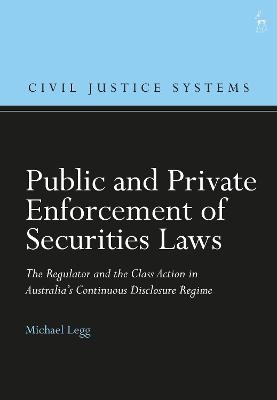
Public and Private Enforcement of Securities Laws
Hart Publishing (Verlag)
978-1-5099-4151-3 (ISBN)
Enforcement of laws is crucial to effective regulation. Historically, enforcement was the province of a government regulator with significant discretion (public enforcement). However, more and more citizens are being expected to take action themselves (private enforcement). Consistent with regulatory pluralism, public and private enforcement exist in parallel, with the capacity to both help and hinder each other, and the achievement of the goals of enforcement in a range of areas of regulation.
The rise of the shareholder class action in Australia, backed by litigation funding or lawyers, has given rise to enforcement overlapping with that of the government regulator, the Australian Securities and Investments Commission. The ramifications of overlapping enforcement are explained based on detailed analysis. The analysis is further bolstered by the regulator’s approach to enforcement changing from a compliance orientation to a “Why not litigate?” approach.
The analysis and ramifications of the Australian case studies involve matters of regulatory theory and practice that apply across jurisdictions. The book will appeal to practitioners, regulators and academics interested in regulatory policy and enforcement, and the operation of regulators and class actions, including their interaction.
Michael Legg is Professor of Law at the University of New South Wales, Australia.
1. Introduction
I. Research Questions
II. Structure of the Text
III. Scope of Study and Text
IV. Case Studies
V. Key Findings
VI. Conclusion
2. Background
I. Introduction
II. Continuous Disclosure
III. Misleading or Deceptive Conduct
IV. ASIC Enforcement
V. Shareholder Class Actions
VI. Conclusion
3. Analytical Framework
I. Introduction
II. Deterrence
III. Compensation
IV. The Regulatory Process
V. Conclusion
4. Case Studies
I. Introduction
II. Methodology
III. Telstra
IV. Multiplex
V. Centro
VI. Leighton
VII. Conclusion – Summary of Case Studies
5. Application of the Analytical Framework to the Case Studies
I. Introduction
II. Application of the Analytical Framework – Deterrence
III. Application of the Analytical Framework – Compensation
IV. Application of the Analytical Framework – Regulatory Process
V. Conclusion 7
6. Effectiveness and Coexistence of Regulatory Enforcement and Class Actions
I. Introduction
II. Effectiveness of ASIC Enforcement and Class Actions
III. Ramifications of ASIC Enforcement and Class Actions Coexistence
IV. Conclusion
7. Public and Private Enforcement Recalibrated
I. Introduction
II. ASIC’s Enforcement Approach Revisited
III. Class Actions Revisited
IV. Reformulating the Continuous Disclosure Laws
V. ASIC Enforcement and Continuous Disclosure Class Actions Post-2017
VI. Conclusion
8. Coordination of Public and Private Enforcement
I. Introduction
II. Why Coordination?
III. Existing Coordination Mechanisms
IV. Coordination in Other Regulatory Regimes
V. Concerns with Coordination
VI. Coordination Strategies for Securities Regulation
VII. Conclusion
Appendix 1
I. Interview Questions for ASIC
II. Interview Questions for Class Action Applicants, Litigation Funders and their Lawyers
III. Interview Questions for Regulated Entity/Class Action Respondents’ Directors/Officers and their Lawyers
IV. Summary of Interviews
V. Interviews with Short Title
Appendix 2
Table 1 Continuous disclosure infringement notices from 1 July 2004 to 30 June 2021
Table 2 Continuous disclosure enforceable undertakings – 1998 to 30 June 2021
Table 3 Continuous disclosure class actions – 2002 to 30 June 2021
| Erscheinungsdatum | 11.02.2022 |
|---|---|
| Reihe/Serie | Civil Justice Systems |
| Verlagsort | Oxford |
| Sprache | englisch |
| Maße | 169 x 244 mm |
| Gewicht | 699 g |
| Themenwelt | Recht / Steuern ► EU / Internationales Recht |
| Recht / Steuern ► Privatrecht / Bürgerliches Recht ► Zivilverfahrensrecht | |
| Recht / Steuern ► Wirtschaftsrecht ► Bank- und Kapitalmarktrecht | |
| ISBN-10 | 1-5099-4151-7 / 1509941517 |
| ISBN-13 | 978-1-5099-4151-3 / 9781509941513 |
| Zustand | Neuware |
| Informationen gemäß Produktsicherheitsverordnung (GPSR) | |
| Haben Sie eine Frage zum Produkt? |
aus dem Bereich


